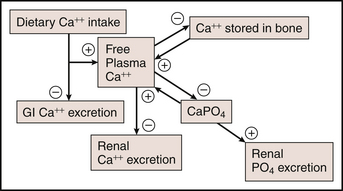65 CASE 65
PATHOPHYSIOLOGY OF KEY SYMPTOMS
Within the body, calcium balance is maintained by regulating dietary intake and absorption against renal excretion. Ninety-nine percent of body calcium is stored in bone complexed to phosphate as hydroxyapatite crystals. The remaining 1% is distributed within the cells (particularly the endoplasmic sarcoplasmic reticulum) and in the extracellular fluid. Normal plasma calcium concentration is 10 mg/dL, 50% of which circulates as ionized (free) calcium, 40% complexed to plasma proteins, and 10% complexed to phosphate, citrate, and other nonprotein anions. Ionized calcium levels represent the balance between dietary absorption, exchange with storage pools, and renal excretion (Fig. 65-1).
< div class='tao-gold-member'>
Only gold members can continue reading. Log In or Register to continue
Stay updated, free articles. Join our Telegram channel

Full access? Get Clinical Tree



